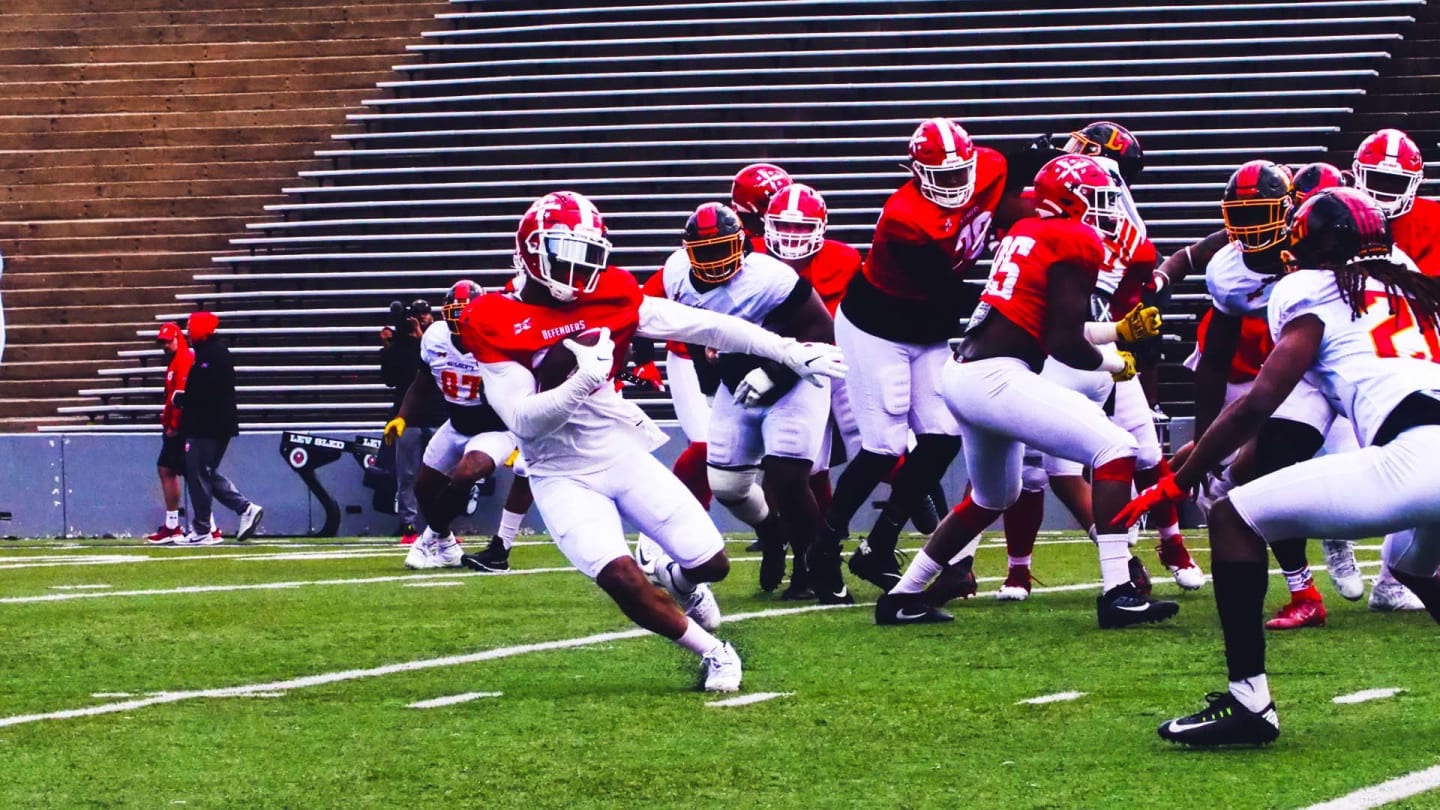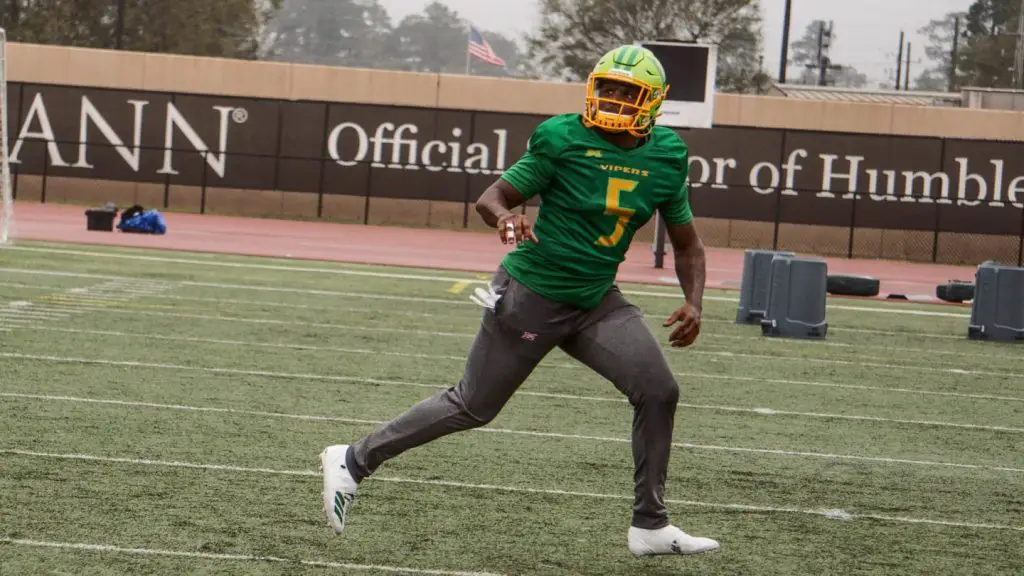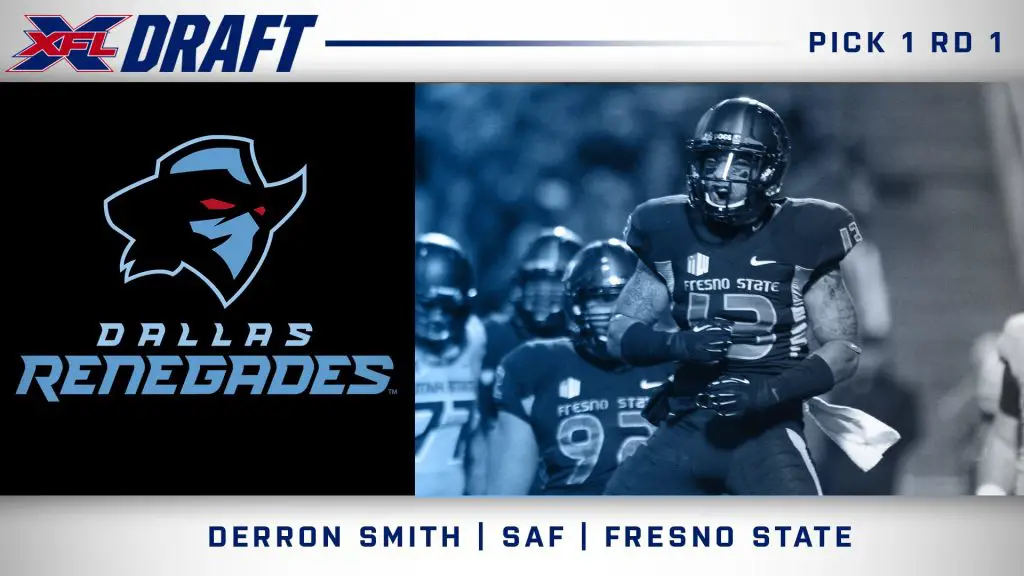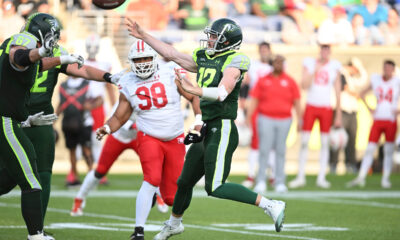
At the start of the new year, I posted fantasy football rankings for every position in the XFL. The list even included kickers and defenses. The XFL’s rules were released, and there have been some changes to team rosters since the new year began. Some key star players were injured, and some have switched teams. The league will be cutting down their rosters this Wednesday. The picture and each depth chart should become more evident as we get closer to the regular season.
LEAGUE STRUCTURE
Daily or Season Long? I always lean towards the latter. What should your XFL fantasy league look like? The XFL has reimagined the rules of football. XFL Fantasy owners might have to reimagine how they usually play fantasy football.
The XFL is an eight-team league. That means eight starting quarterbacks and eight starting running backs. I am leaning towards playing in an eight-owner league. I like the idea of making it even more challenging.
Many fantasy players will lean towards a six-owner structure to have more player depth. A season-long XFL fantasy football league could resemble the XFL. 8 teams, two divisions with four teams making the playoffs. It’s a ten-week regular season. So the season length should be eight weeks with weeks nine and ten being the playoff weeks. To up scoring, all leagues should probably be a full point PPR setup.
An 8-team league means studying depth charts more than you usually would in the NFL. Handcuffing players and finding hidden gems will be the key to success. Since there are no bye weeks, and there is less depth. You are going to need to draft and trade well.
Your weekly starting roster might look something like this;
QB, RB, RB, WR, WR, WR, TE, K & D/ST.
The bench rules of your league might be tricky. There won’t be a need to have backup kickers or defenses, with no bye weeks or streaming potential. Tight end should be a secure position to navigate, as well. Some teams will utilize two, and one in Houston, will not use any.
There will be plenty of depth at the receiver position. Most teams will feature three or more receivers weekly. Some of the XFL’s teams have lineups that feature multiple starting receiver sets like the Houston Roughnecks (4).
The bench dilemma exists at the quarterback and running back positions. With only eight starting running backs. The max amount of starters per fantasy team will probably be two. In the age of running back by committee, each XFL team could feature more than two runners per game.
The key is going to be in identifying who those players will be. Some fantasy leagues may opt for a team quarterback drafting system. Rather than having team owners draft backup quarterbacks on their bench, like handcuffing Connor Cook with Phillip Walker. In one fell swoop, you select a team’s quarterbacks instead.
SCORING UPDATE
The NFL does not record statistics during two-point conversion attempts. Fantasy leagues and the NFL do recognize conversion points on the stat sheet, but not the receptions or yardage gained during these attempts. Defensive stats are also not registered during conversions like sacks, interceptions, tackles, fumble recoveries, etc.
The XFL will also follow suit and keep the same model as the NFL even though the league will be having conversion attempts from the 2, 5, and 10-yard lines. The point-after-touchdown plays in the XFL will still have fantasy relevance since offensive players will have the opportunity to score 1, 2, or 3 points extra after every touchdown. Defenses can also score during conversions.
The conversion points go on a fantasy player’s stat sheet. However, the yardage on a Connor Cook to Sammie Coates ten-yard conversion score does not. It would have made for an impressive stat line if those plays counted.
UPDATED XFL2020 FANTASY FOOTBALL RANKINGS BY POSITION
QUARTERBACKS
1-Cardale Jones- DC Defenders
Cardale Jones got himself a rocket boost with the addition of deep-threat Rashad Ross.

2-Connor Cook- Houston Roughnecks
Connor Cook is in a battle with Phillip Walker for the starting job. Cook appears to be in the driver’s seat. The winner of this competition is poised to put up big numbers in the Run & Shoot.
3-Josh Johnson- Los Angeles Wildcats
Johnson still has a strong supporting cast, even with the recent loss of Ross. Players like KD Cannon have emerged, and Tre McBride should fit in nicely in Norm Chow’s scheme.
4-Landry Jones- Dallas Renegades
Fantasy owners may get a bargain if Landry falls in a draft due to his knee injury. Hal Mumme’s Air-Raid is tailor-made for Landry when he returns.
5-Matt McGloin- New York Guardians
McGloin has arguably the best red-zone targets in the league, with Mekale McKay, Tanner Gentry, and DeAngelo Yancey at his disposal.
6-Brandon Silvers- Seattle Dragons
Silvers has come on as of late. The competition with BJ Daniels and the returning Joe Callahan has benefitted him.
7-Jordan Ta’amu- St. Louis BattleHawks
The coordinator switch from Doug Meacham to Chuck Long is a temporary hiccup. The return of DeMornay Pierson-El from the NFL should help Ta’amu or whoever wins the job before the season starts.
8-Aaron Murray- Tamp Bay Vipers
The Vipers have added two big-play receivers recently in Antonio Callaway and Stacy Coley. Murray may be sharing time at Quarterback, with the ultimate swiss-army knife, Quinton Flowers.
RUNNING BACKS
1- Cameron Artis Payne- Dallas Renegades
Payne could see more carries and scoring opportunities early in the season, as a result of the Landry Jones injury.

2- Jhurell Pressley- DC Defenders
The only thing keeping Pressley’s stock from rising is that DC is going to be utilizing a committee backfield with Donnel Pumphrey. The time-share puts a cap on Pressley’s overall production.

3- Christine Michael- St. Louis BattleHawks
The change in coordinator may benefit STL’s ground attack. The transition in such a short amount of time may push the BattleHawks to simplify things in the early stages of the season. St. Louis may lean on Michael more.
4- Kenneth Farrow- Seattle Dragons
Farrow is a strong candidate for 15-20 carries per game. Farrow should be the Dragons go to back in the red-zone.
5- Andre Williams- Houston Roughnecks
The Roughnecks will be pass-heavy, but Williams stands to benefit from defenses forced to line up in the dime on every play.
6- Donnel Pumphrey- DC Defenders
The fantasy situation in DC is similar to Alvin Kamara/Mark Ingram in New Orleans a couple of years ago. Pressley and Pumphrey are worthy of being weekly starters, despite being on the same team. The key to Pumphrey will be his durability, but if he stays on the field. Pumphrey is going to be a quality weekly starter in fantasy.
7- Trey Williams- Seattle Dragons
Williams is very similar to Pumphrey in DC. He should be one of the league’s better receiving backs.
8- Tim Cook- New York Guardians
Cook is a 240-pound bruiser who has double-digit touchdown potential. Darius Victor and Matthew Colburn could push for playing time.
9- Elijah Hood- Los Angeles Wildcats
Hood is very similar to Cook. He’s in a good offense and has the potential to get a lot of scoring opportunities in the red-zone. The Wildcats offensive line is huge and should be competent in power sets. Hood was the eight pick in LA’s draft back in October.
10- DeVeon Smith- Tampa Bay Vipers
The Tampa Bay backfield has a ton of question marks. There is no clear cut #1 as of press time. Any number of the Vipers backs are in contention for this role — Smith projects as a goal-line back.
11- Matt Jones- St. Louis BattleHawks
On paper, St. Louis has the most experienced and talented running back duo in the league. Jones will be worthy of weekly starter consideration.
12- Lance Dunbar- Dallas Renegades
The most experienced third-down back in the league. A quality change of pace back for the Dallas offense.
13- Justin Stockton- New York Guardians
Potential breakout player. Stockton has 4.3 speed and had a very productive career at Texas Tech in Kliff Kingsbury’s offense. The Guardians’ backfield has bowling ball style runners in Cook and Darius Victor. Stockton’s big-play ability and receiving skills should be a nice contrast.
14- Larry Rose III- Los Angeles Wildcats
Rose broke records at New Mexico State. An all-purpose back who was the offensive player of the year in the Sun-Belt. Norm Chow has a history of featuring this style of running back in his passing game.
15- Quinton Flowers- Tampa Bay Vipers
has Flowers listed as a running back on their team roster page. The XFL has its fair share of Taysom Hill types all over the league. Flowers will factor into the Vipers offense every single week. He’s got big-play potential as a runner, receiver, and throwing the football. The XFL rules are tailor-made for Quinton Flowers. He should be involved in every red zone and point after touchdown package.
16- JaQuan Gardner- Seattle Dragons
The ranking for Gardner is a bit high. He’s projected to be the third wheel in Seattle’s backfield and is coming off an injury in the AAF. JaQuan Gardner is exceptionally talented. He can break tackles in the open field and has breakaway ability. Gardner is a real handcuff to Farrow, more so than Trey Williams. Trey is a third-down type back who has a specific role for the team. Gardner could be a 20 carry a game player if anything were to happen to Farrow.
WIDE RECEIVERS
1- Sammie Coates- Houston Roughnecks
Coates is maturing as a player and is fitting June Jones WR friendly offense like a glove. He’s going to be one of the league’s most significant break out players and is in an attack that might throw the ball 50 times per game. XFL CEO Oliver Luck has even commented on Coates during recent press interviews.

2- Rashad Ross- DC Defenders
‘Rocket’ Ross is even more of a fit in Pep Hamilton’s offense than he was in LA with Norm Chow. Offensive Line/Run Game Coordinator Chris Scelfo spent time with Ross in Arizona. Scelfo knows the value of having a serious deep threat in combatting eight-man defensive fronts. The presence of Ross will open up the DC ground game.
3- Jeff Badet- Dallas Renegades
In Hal Mumme’s offense, Badet’s 4.2 speed will be useful in throwing the ball down the field. In the Air-Raid attack, bubble screens and crossing routes will be a regular play design, to take advantage of Badet’s speed and acceleration. I fully expect Jeff Badet to be one of the league’s best big-play receivers. Regardless of who is throwing the football for Dallas.
4- Mekale McKay- New York Guardians
McKay has a chance to lead the league in red-zone targets. He may be the league’s best jump-ball receiver.
5- Eli Rogers- DC Defenders
Rashad Ross will get plenty of attention from defenses. Rogers will probably lead the team in targets and receptions. The argument can be made that Rogers is the league’s best inside receiver.
6- Nelson Spruce- Los Angeles Wildcats
Spruce has the potential to be a highly productive PPR machine.
7- Antonio Callaway- Tampa Bay Vipers

Drafting Callaway is a massive leap of faith. Can he be trusted, and can he be reliable?…. Antonio Callaway is just what the doctor ordered for the Vipers offense. He’s a playmaker and one of the most talented receivers in the league.
8- DeAngelo Yancey- New York Guardians
Yancey is a real sleeper, but the truth is he shouldn’t be one. Yancey is a polished route-runner with excellent hands. He has the size to be a factor in the red zone and the ability to make plays all over the field. There is a reason that New York drafted him first at the position.
9- Terrence Williams- St. Louis Battlehawks
Williams is very similar to the Renegades Lance Dunbar. He has a ton of experience. His name value alone will get him drafted high. St. Louis has a good group of receivers. The change in coordinator is a factor, and Williams has some competition for targets. Will he be the BattleHawks true #1?
10- Jazz Ferguson- Dallas Renegades
Jeff Badet will be taking the top off of defenses. Jazz Ferguson will be running some of them over. The jumbo-sized receiver at 6’5 and 225 pounds has had a great January. Ferguson is one of the best sleepers at the receiver position in the league. He has DK Metcalf type ability. After transferring from LSU, Ferguson had 13 touchdowns and 17 yards per catch in his final college season at Northwestern State.
11- L’Damian Washington- St. Louis Battlehawks
Carlton Agudosi is also pushing for playing time and a starting role in the Saint Louis offense. Washington is a well-traveled veteran who has stood out in training camp. Washington, at 6’4, has the size and speed to be a factor all over the field. The key will be developing chemistry and cohesion with his quarterbacks and in Chuck Long’s offense.
12- Reece Horn- Tampa Bay Vipers
Horn started to emerge as one of the most reliable pass-catchers in the AAF. A small school gem out of Indy, Horn is going to be worthy of being a weekly starter in PPR leagues.
13- KD Cannon- Los Angeles Wildcats
The trade of Rashad Ross has opened things up for someone in LA to emerge as the teams’ go-to guy at receiver. Cannon has the size, speed, and open field ability to match the production he had at Baylor.
14- Keenan Reynolds- Seattle Dragons
Seattle is going to be one of the hardest teams to project from a fantasy perspective. Fred Ross was their first receiver drafted. Kasen Williams is a polished veteran with excellent red-zone skills. Jalen Rowell has big-play potential, as he showed at Air Force, leading the nation in yards per catch. Korey Robertson is a size-speed guy who emerged late in his college career. Any one of these players can be weekly contributors. Reynolds is a safe pick because he will factor into the offense a lot, as a runner, receiver, and in the red zone.
15- Tre McBride- Los Angeles Wildcats
McBride and DC weren’t a fit. It came to the point where Tre was considering not playing in the XFL. McBride revealed this in a recent interview with Haley Graves from the LA Wildcats. McBride is back home, and his 4.3 speed and experience will be an asset for Los Angeles. McBride can play inside and outside and make plays in space.
16- Khalil Lewis- Houston Roughnecks
You can’t go wrong selecting any of Houston’s receivers. The Roughnecks will be starting four wide receivers every single game. June Jones has a history dating back to the USFL of finding hidden gems at the receiver position. He takes great pride in it. It’s worth noting that Lewis was the very first receiver that Jones selected in the skill-position draft.
17- Jalen Saunders- Houston Roughnecks
Saunders has the potential to be an excellent asset for all the Roughnecks receivers. Jalen Saunders knows the June Jones system well and has played in it in the past.
18- De’Mornay Pierson-El- St. Louis BattleHawks
Pierson-El was the first receiver drafted by St. Louis back in October. He’s returned to STL after ending the season on the Raiders roster. Pierson-El did not take any futures contracts offered his way by NFL teams. St. Louis has a ton of big targets at receiver. De’Mornay is the perfect contrast to their receiving corps. He has excellent after the catch skills and could be the teams’ best inside receiver.
19- DeAndre Thompkins- DC Defenders
Pep Hamilton has singled out Thompkins in interviews with the DC media. Thompkins has 4.31 speed and is a lot like Pierson-El in St. Louis. DeAndre is a dynamic returner and has excellent open-field skills. Thompkins should see plenty of single coverage, with Rashad Ross and Eli Rogers as teammates.
20- Freddie Martino- Dallas Renegades
In an under the radar move, Daryl Johnston and Bob Stoops traded away Stacy Coley to Tampa for Martino. Coley and Tommy Lee Lewis were two of the Renegades top draft picks back in October. Neither of them is on the roster now. Ryan Broyles retired. There is a clear opening for a player to emerge as a slot receiver on this team. Martino was a record-breaking receiver in Division II, catching 146 passes in one season. Martino is not a straight line speed player, but he does have a track background and is an excellent route runner. If he picks up the Dallas offense quickly, he could be a real factor on game days.
TIGHT ENDS

1- Nick Truesdell- Tampa Bay Vipers
Tampa drafted him first, fifth overall. The Vipers have bolstered their receiving crew, which could make Truesdell’s job easier.
2- Brandon Barnes- Los Angeles Wildcats
Barnes has had an excellent camp for LA. Barnes can be a reliable option for Josh Johnson in the red-zone.
3- Khari Lee- DC Defenders
Lee should benefit from all the weapons that DC has. His size should help in the passing game.
4- Donald Parham- Dallas Renegades
-Freakish talent. 6’8. 36-inch vertical leap, with an 84-inch wingspan. He should be a favored target in the red zone. Parham is a diamond in the rough.
5- Evan Rodriguez- Seattle Dragons
Jim Zorn and Mike Riley will feature the tight end in their passing attack.
6- EJ Bibbs- New York Guardians
Bibbs is an experienced vet operating in a system that is ideally suited for his talents.
7- Sean Price- Dallas Renegades
The Renegades have a great combo at the position. Price has good hands and can make plays all over the field.
8- Connor Davis- St. Louis BattleHawksDavis is 6’8 260 pounds and is a great athlete. A Jonathan Hayes coached team is an ideal spot for a potential breakout player like Connor Davis.
KICKERS

1- Cole Tracy- Seattle Dragons
2- Austin MacGinnis- Dallas Renegades
3- Nick Novak- Los Angeles Wildcats
4- Matt McCrane- New York Guardians
5- Taylor Russolino- St. Louis BattleHawks
6- Sergio Castillo- Houston Roughnecks
7- Andrew Franks/Matthew Wright- Tampa Bay Vipers
8- Hunter Niswander- DC Defenders
No PFT Commenter or Chad Johnson listed here.
DEFENSE/SPECIAL TEAMS

1- Dallas Renegades
2- New York Guardians
3- DC Defenders
4- Tampa Bay Vipers
5- St. Louis BattleHawks
6- Los Angeles Wildcats
7- Houston Roughnecks
8- Seattle Dragons
It’s almost impossible to rank this accurately without actual games to play off of. In truth, you can reverse this list. Dallas appears to have the best pass-rush with Kikaha and Markus Jones, along with the best safety in Derron Smith.
The Guardians might have the league’s best secondary. The Defenders are very balanced. The Vipers have great size and an elite pass-rushing trio. St. Louis is stout on the inside and back-end of their defense and has excellent returners. LA is playing a traditional 3-4 and has excellent size upfront. The Roughnecks have good veteran players. The Dragons are very young and talented. Channing Stribling has had a terrific camp.
As is the case with many teams in the XFL. There will be players that emerge out of nowhere and make a name for themselves. As a fantasy owner for a first-year league. You don’t have the benefit of previous seasons or even preseason games. This dynamic will make fantasy football in the XFL even more exciting and challenging.
Unleash the Action: Sign up for XFL Insider and Fuel Your Passion for Football!
I am a pro football writer who has extensively covered and reported on multiple leagues over the years. I started covering the XFL back in 2001. You can follow me on Twitter @byMikeMitchell

USFL and XFL Merger: A Deep Dive into the Historic Collaboration
Latest Podcast
-


XFL Podcast
/ 1 year agoXFL-USFL Merger Insights: Houston’s Future, Draft News, Player Movement – Ep. 216
Welcome to Episode 216 of the “XFL Week In Review,” your premier destination for...
By Mark Perry







